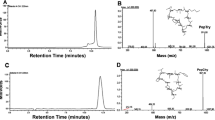Abstract
Human chymase, an angiotensin II-forming chymotrypsin-like serine proteinase, posses various biological actions mediating through local angiotensin II formation in the tissue level of many cardiovascular organs. Our previous experimental data have shown that chymase inhibitor increased a survival rate of the hamster post-myocardial infarction model with concomitant improvements of the cardiac function and hypertrophy, decreased hamster aortic atherosclerotic lesion induced by a high fat diet and improved hamster diabetic nephropathy decreasing the proteinuria and increased renal antiotensin II levels. Although chymase inhibitor has not yet been applied for clinical use, clinical cardiovascular diseases above mentioned appear to be the target of chymase inhibitor. The related basal and clinical circumstances are discussed in this review article for chymase inhibitor.


Similar content being viewed by others
References
Dzau VJ. Molecular and physiological aspects of tissue renin-angiotensin system: emphasis on cardiovascular control. J Hypertens. 1988;6(supplement):S7–12.
Dzau VJ. Circulating versus local renin-angiotensin system in cardiovascular homeostasis. Circulation. 1988;77:I4–13.
Nishiyama A, Seth DM, Navar LG. Renal interstitial fluid angiotensin i and angiotensin ii concentrations during local angiotensin-converting enzyme inhibition. J Am Soc Nephrol. 2002;13:2207–12.
Urata H, Nishimura H, Ganten D. Chymase-dependent angiotensin ii forming systems in humans. Am J Hypertens. 1996;9:277–84.
Urata H, Boehm KD, Philip A, Kinoshita A, Gabrovsek J, Bumpus FM, et al. Cellular localization and regional distribution of an angiotensin ii-forming chymase in the heart. J Clin Invest. 1993;91:1269–81.
Li M, Liu K, Michalicek J, Angus JA, Hunt JE, Dell’Italia LJ, et al. Involvement of chymase-mediated angiotensin ii generation in blood pressure regulation. J Clin Invest. 2004;114:112–20.
Yusuf S, Teo KK, Pogue J, Dyal L, Copland I, Schumacher H, et al. Telmisartan, ramipril, or both in patients at high risk for vascular events. N Engl J Med. 2008;358:1547–59.
Pfeffer MA, McMurray JJ, Velazquez EJ, Rouleau JL, Kober L, Maggioni AP, et al. Valsartan in Acute Myocardial Infarction Trial I. Valsartan, captopril, or both in myocardial infarction complicated by heart failure, left ventricular dysfunction, or both. N Engl J Med. 2003;349:1893–906.
Adachi Y, Saito Y, Kishimoto I, Harada M, Kuwahara K, Takahashi N, et al. Angiotensin ii type 2 receptor deficiency exacerbates heart failure and reduces survival after acute myocardial infarction in mice. Circulation. 2003;107:2406–8.
Brenner BM, Cooper ME, de Zeeuw D, Keane WF, Mitch WE, Parving HH, et al. Effects of losartan on renal and cardiovascular outcomes in patients with type 2 diabetes and nephropathy. N Engl J Med. 2001;345:861–9.
Lewis EJ, Hunsicker LG, Clarke WR, Berl T, Pohl MA, Lewis JB, et al. Renoprotective effect of the angiotensin-receptor antagonist irbesartan in patients with nephropathy due to type 2 diabetes. N Engl J Med. 2001;345:851–60.
Iwai M, Liu HW, Chen R, Ide A, Okamoto S, Hata R, et al. Possible inhibition of focal cerebral ischemia by angiotensin ii type 2 receptor stimulation. Circulation. 2004;110:843–8.
Ihara M, Urata H, Kinoshita A, Suzumiya J, Sasaguri M, Kikuchi M, et al. Increased chymase-dependent angiotensin ii formation in human atherosclerotic aorta. Hypertension. 1999;33:1399–405.
Ihara M, Urata H, Shirai K, Ideishi M, Hoshino F, Suzumiya J, et al. High cardiac angiotensin-ii-forming activity in infarcted and non-infarcted human myocardium. Cardiology. 2000;94:247–53.
Uehara Y, Urata H, Sasaguri M, Ideishi M, Sakata N, Tashiro T, et al. Increased chymase activity in internal thoracic artery of patients with hypercholesterolemia. Hypertension. 2000;35:55–60.
Murakami K, Uehara Y, Abe S, Inoue Y, Ideishi M, Saku K, et al. Positive correlation between chymase-like angiotensin ii-forming activity in mononuclear cells and serum cholesterol level. J Cardiol. 2007;50:291–8.
Okamura K, Inoue Y, Uehara Y, Maruyama S, Sumi S, Furuyama S, et al. Chymase dependent angiotensin ii-forming activity in the circulating mononuclear leukocyte increases post acute myocardial infarction the 73rd annual scientific meeting of the japanese circulation society. Circ J. 2009;73:490.
Hoshino F, Urata H, Inoue Y, Saito Y, Yahiro E, Ideishi M, et al. Chymase inhibitor improves survival in hamsters with myocardial infarction. J Cardiovasc Pharmacol. 2003;41 Suppl 1:S11–8.
Wei CC, Hase N, Inoue Y, Bradley EW, Yahiro E, Li M, et al. Mast cell chymase limits the cardiac efficacy of ang i-converting enzyme inhibitor therapy in rodents. J Clin Invest. 2011;120:1229–39.
Shiota N, Jin D, Takai S, Kawamura T, Koyama M, Nakamura N, et al. Chymase is activated in the hamster heart following ventricular fibrosis during the chronic stage of hypertension. FEBS Lett. 1997;406:301–4.
Uehara Y, Urata H, Ideishi M, Arakawa K, Saku K. Chymase inhibition suppresses high-cholesterol diet-induced lipid accumulation in the hamster aorta. Cardiovasc Res. 2002;55:870–6.
Maeda Y, Inoguchi T, Takei R, Sawada F, Sasaki S, Fujii M, et al. Inhibition of chymase protects against diabetes-induced oxidative stress and renal dysfunction in hamsters. Am J Physiol. 2010;299:F1328–38.
Chandrasekharan UM, Sanker S, Glynias MJ, Karnik SS, Husain A. Angiotensin ii-forming activity in a reconstructed ancestral chymase. Science. 1996;271:502–5.
Akasu M, Urata H, Kinoshita A, Sasaguri M, Ideishi M, Arakawa K. Differences in tissue angiotensin ii-forming pathways by species and organs in vitro. Hypertension. 1998;32:514–20.
Wei CC, Hase N, Inoue Y, Bradley EW, Yahiro E, Li M, et al. Mast cell chymase limits the cardiac efficacy of ang i-converting enzyme inhibitor therapy in rodents. J Clin Invest. 2010;120:1229–39.
Author information
Authors and Affiliations
Corresponding author
Rights and permissions
About this article
Cite this article
Tojo, H., Urata, H. Chymase Inhibition and Cardiovascular Protection. Cardiovasc Drugs Ther 27, 139–143 (2013). https://doi.org/10.1007/s10557-013-6450-4
Published:
Issue Date:
DOI: https://doi.org/10.1007/s10557-013-6450-4




